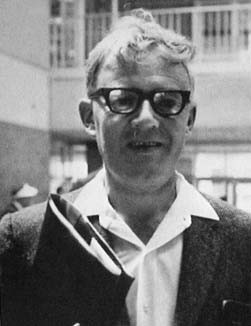-
(b.) -1917 May 14(d.)2002 May 02
Bio/Description
A British, later Canadian codebreaker and mathematician, he was born in Newmarket in Suffolk, the son of a gardener. At the age of 18, he studied Chemistry and Mathematics at Trinity College, Cambridge University. As a student he, along with three of his friends, became the first to solve the problem of squaring the square. Together the four created the pseudonym Blanche Descartes, under which he published occasionally for years. He completed a Doctorate in Mathematics from Cambridge in 1948 under the supervision of Shaun Wylie, with whom he had worked at Bletchley Park on TUNNY. The same year, invited by Harold Scott MacDonald Coxeter, he accepted a position at the University of Toronto. In 1962, he moved to the University of Waterloo in Waterloo, Ontario where he stayed for the rest of his academic career. He officially retired in 1985 but remained active as an emeritus professor. He was instrumental in helping to found the Department of Combinatorics and Optimization at the University of Waterloo. His mathematical career concentrated on combinatorics, especially graph theory, which he is credited as having helped create in its modern form; and matroid theory, to which he made profound contributions; one colleague described him as "the leading mathematician in combinatorics for three decades". He was editor in chief of The Journal of Combinatorial Theory when it was started, and served on the editorial boards of several other mathematical research journals. His work in graph theory includes the structure of cycle and cut spaces, size of maximum matchings and existence of k-factors in graphs, and Hamiltonian and non-Hamiltonian graphs. He disproved Tait's conjecture using the construction known as Tutte's fragment. The eventual proof of the four color theorem made use of his earlier work. The graph polynomial he called the "dichromate" has become famous and influential under the name Tutte polynomial and serves as the prototype of combinatorial invariants that are universal for all invariants that satisfy a specified reduction law. In matroid theory he discovered the highly sophisticated homotopy theorem as well as founding the studies of chain groups and regular matroids, about which he proved deep results. On the outbreak of World War II, his tutor suggested he join the Government Code and Cypher School at Bletchley Park. He made a brilliant and fundamental advance in Cryptanalysis of the Lorenz cipher, a major German code system, which had a significant impact on the Allied invasion of Europe. Originally rejected in interview by Alan Turing for a message code breaking team, he was recruited by John Tiltman for the research section in May 1941, which actually turned out to be the best choice. His work there allowed him, from basic mathematical analysis, to deduce the structure of the German Lorenz SZ 40/42 encryption machine (codenamed TUNNY), that used for high-level German Army communications. On 30 August 1941, the German High Command sent a single message twice (a "depth"), allowing Tiltman to break the message code by deducing the obscuring key. Tiltman then handed it and some other Tunny keys to him, who after writing out by hand the original teleprinter 5-character Baudot code, made an initial breakthrough by recognizing a 41-character repeat. Over the following two months, he and other members of the Research section worked out the complete logical structure of the cipher machine. This achievement was later described as "one of the greatest intellectual feats of World War II". Using his breakthrough, bulk Cryptanalysis of the Lorenz cipher became possible. Because of this work, Canada's Communications Security Establishment named an internal organization aimed at promoting research into cryptology, the Tutte Institute for Mathematics and Computing (TIMC) in his honour in 2011. He was a Fellow of the Royal Society of London, and of the Royal Society of Canada. In 2001 he was inducted as an Officer of the Order of Canada and won the CRM-Fields-PIMS prize.
-
Date of Birth:
1917 May 14 -
Date of Death:
2002 May 02 -
Gender:
Male -
Noted For:
Performed significant foundational work in the fields of combinatorics which has many applications in computer science; and graph theory which in mathematics and computer science, is the study of mathematical structures used to model pairwise relations between objects from a certain collection -
Category of Achievement:
-
More Info:


